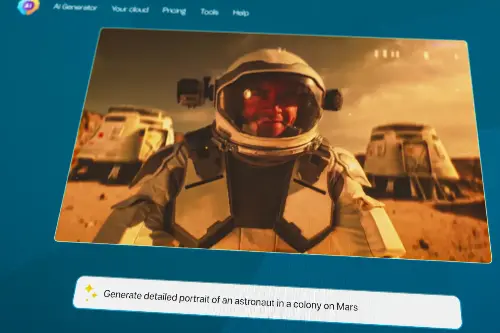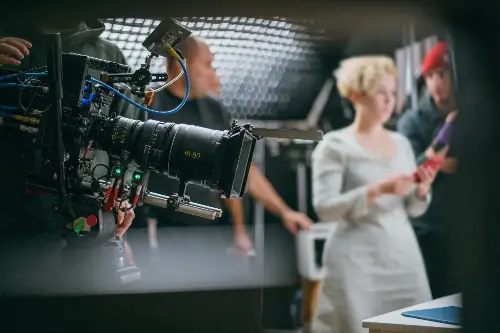From early experiments in film to the dazzling array of effects we see on the silver screen today, technology has relentlessly pushed the boundaries of what is possible in movie-making. Since filmmakers first learned to splice film and create illusions, we've been on a journey of discovery and innovation.
The computer revolution brought with it tools that revolutionised special effects, taking the audience into worlds only imagined in dreams. But now, a new player has entered the arena: generative artificial intelligence (AI) is poised to unleash a new wave of creativity and redefine what's possible, not only in the realm of special effects but in every aspect of filmmaking.

The Rise of AI in Visual Effects
It was not long ago that CGI, or computer-generated imagery, was seen as the pinnacle of visual effects. Masters of the craft would spend countless hours rendering frames to bring the impossible to life. Imagine dragons soaring through fantastical landscapes, epic spaces battles in galaxies far, far away, and mythical creatures interacting with humans in modern-day metropolises—these were all made possible with CGI. Yet, CGI has always been an expensive and time-consuming process, putting it slightly out of reach for independent filmmakers with more limited budgets.
Enter AI technology—tools like DALL.E, Midjourney, and Firefly have proven that not only can AI create complex and artistic images from simple text descriptions, but it can also do so rapidly and at scale. Suddenly, the tap-dancing cat on a tightrope is not only a whimsical daydream but a visual possibility within reach.
AI in Post-Production
But AI's potential extends far beyond stationary images. It has unprecedented capabilities in the realm of post-production. With advanced AI, filmmakers can alter a scene's details in ways previously unimaginable. An actor's attire, the unwanted object in a shot, or even a performer's age or expression can be adjusted after the fact with an ease that would have been dismissed as science fiction a mere decade ago.
One of the most controversial advancements comes in the form of AI clones or 'deepfakes'. They can create highly realistic avatars that not only mimic real actors but can also generate entirely new characters from scratch. These digital entities are so convincing in their movements and speech that they have sparked a debate about the essence of performance and the nature of acting itself.

The Next Generation of AI Tools
The future is even more promising—or daunting, depending on your perspective—as recent advancements by companies like OpenAI and Google DeepMind have been shining a spotlight on the capabilities of AI in generating video clips. With these new tools, stunning video content that encapsulates almost any conceived scenario can be produced in mere seconds. This monumental leap in technology is significant not just for the potential it holds but for the democratization of filmmaking it suggests. Suddenly, anyone with a computer can potentially create cinema-quality films using AI-generated footage.
The Industry's Reaction to Artificial Intelligence
The journey of AI in film has not been without its resistance, however. The introduction of such technology has stirred up a cacophony of concerns across the industry. The upheaval culminated in a significant strike by writers and actors in 2023, a testament to the unease AI advancements have spurred amongst the creative community. The concern is manifold: AI could potentially deprive skilled practitioners of their livelihoods, there's the legal quagmire surrounding the use of copyrighted content for training AI, and then there's the question of originality. AI, in its current form, learns from existing materials, leading to a debate about its capability for genuine creativity.
The Long-Term Impact on the Film Industry
The forecast for AI's influence over the long term is stormy and uncertain. Questions remain about the potential loss of the 'special' in special effects when visual elements can be conjured up effortlessly and cheaply. Could the marvel of effects we once celebrated become mundane when the synthetic becomes easily attainable? Could this be the demise of a unique drawcard that has traditionally lured audiences into cinemas?
There are also current technological limitations: AI-generated content often carries subtle glitches that can unsettle an audience, holding it back from taking centre stage without significant human intervention and editing.

Returning to What Matters in Film
However, when used judiciously as another tool in postproduction, AI could potentially pave the way for a renaissance in cinematic storytelling. With AI handling some of the technical heavy lifting, filmmakers might be able to focus anew on the heart of what makes movies truly memorable—the stirring performance of an actor, the poetic composition of a scene, and the power of a gripping narrative. AI, then, does not have to be a replacement but a complement that helps creators return to the essence of the art form.
As we stand on the precipice of an AI-infused future, the film industry is facing a period of reflection and adaptation. The stage is set not just for a transformation of the technical processes behind movies but also for a reevaluation of the very values and priorities that drive cinematic excellence. AI may be striking at the heart of traditional filmmaking, but it also carries the potential to transport us to uncharted creative territories, with opportunities as boundless as the imagination itself.
